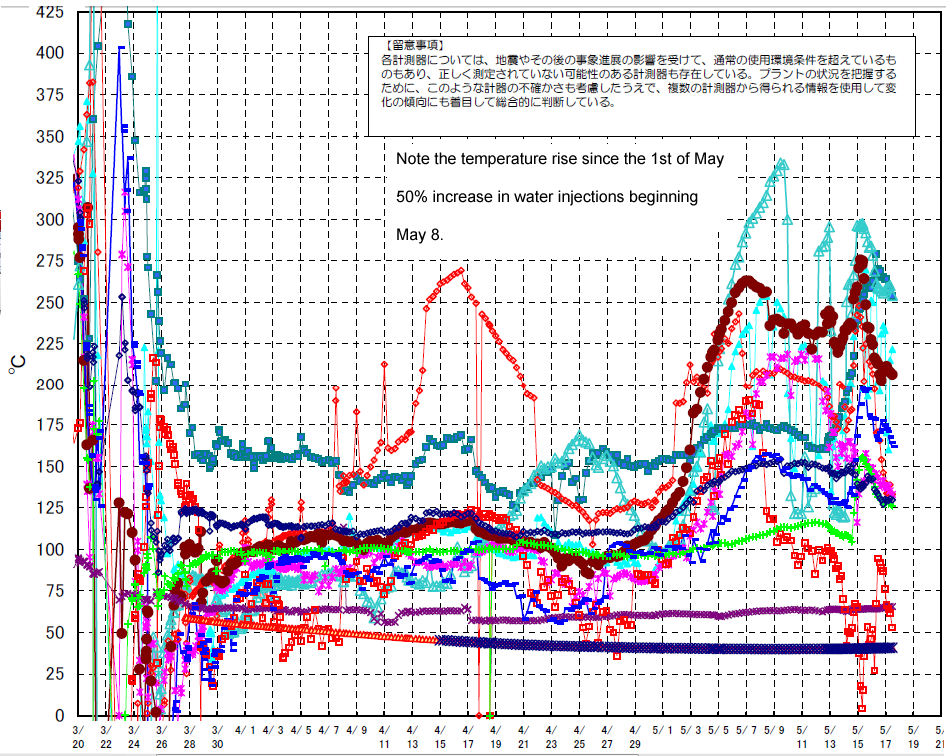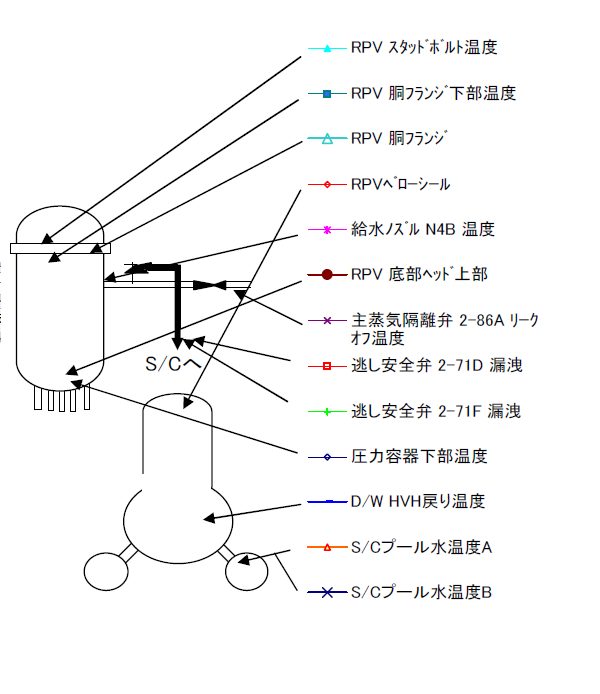Now that two months have passed since earthquake and explosions and world attention is riveted on the incredible and amazing peccadilloes of goofballs in high places involving hotel maids and housekeepers the Japanese government and its largest electric utility Tokyo Electric Power Company (TEPCO) feel safe to confess to multiple meltdowns at their Fukushima reactors.
Nobody is paying attention. It’s a good strategy.
This is after months insisting that the reactor cores were intact and being cooled by the injection of hundreds of tons of water into each plant every day.
Where does this water go? What’s in it?
(Silence … )
What is taking place in Japan mirrors the flawed guarantee gesture made by the Irish government toward that country’s melting banks:
The new enervated Tepco
(Sentaku)Although the government and Tokyo Electric Power Co. (Tepco), the operator of the ill-fated plant, have worked out plans to pay compensation to victims of the crisis, it appears they are interested less in protecting people from radiation than in preserving the existing semi-monopolistic system of the power industry and in enabling the government of Prime Minister Naoto Kan to survive. Japan has 10 electric power companies, each of which is given a monopoly of generating and distributing power within a designated region.
Some observers say the government and Tepco have sought to “trivialize” the effect of the Fukushima accidents by working out a scenario in which the power company, which should bear the total responsibility, survives with “public funding.” The public at large ultimately picks up the whole bill.
Under that scenario, a new organization would be established to help Tepco oversee compensation payments to nuclear accident victims. The new body would guarantee the survival of Tepco. Not only would the government fund the new body but also the other regional power companies with nuclear plants — by chipping in their share as insurance premiums for future accidents.
Even by selling its assets and cutting executive and employee remuneration, Tepco would not be able to pay all compensation claims resulting from the Fukushima plant accidents. The eventual financial burden would be borne by people in the form of taxes and higher electricity rates.
One factor that has given rise to this haphazard scenario is the need to prevent feared chaos in the financial market if Tepco were to go under. Tepco’s share plummeted from the pre-accident price of around ¥2,100 to a mere ¥292 at one point after March 11. Although it recovered to nearly ¥500 after the government’s support program and Tepco’s road map for bringing the Fukushima nuclear crisis under control were announced, further damage to the reactors or serious radioactive leaks could very well make Tepco shares worthless.
Tepco’s interest-bearing liabilities, including corporate bonds, total more than ¥7.3 trillion, most of which is owed to insurance companies and financial institutions, both private and government-owned. The biggest lender is the Development Bank of Japan, which is 100 percent state-owned. It has lent more than ¥300 billion to Tepco.
Shortly after the Fukushima plant accidents, major banks committed another ¥2 trillion in credit lines to Tepco, including ¥600 billion from Sumitomo Mitsui Banking Corp.
Should Tepco go bankrupt, not only would the Japanese financial market be thrown into an utter chaos, but international markets would lose their trust in Japanese banking institutions to the extent that the institutions would have to pay higher interest rates to secure funds.
If worse comes to worst, Tepco share certificates would become worthless sheets of paper for 600,000 shareholders as well as for many corporate pension funds that have included Tepco stock in their portfolios. The steep drop in Tepco’s stock price has already dealt a blow to investment funds in the United States. Nearly 20 percent of its stock is held by non-Japanese investors. This has reportedly led the Obama administration to urge the Kan government to take steps to prevent a further decline in Tepco stock.
Priorities: who cares about the people or the countryside or the neighboring countries? “Get that stock price up there,” the Obama administration commands! So far no suggestions to the Japanese about how to accomplish this.
Now that the meltdown cat is out of the bag, what happens next?
(Nothing … )
TEPCO’s resources to address the massive issues are very limited and shrinking. At the same time, there is no upper limit to the costs. A good- sized part of Fukushima prefecture will be uninhabitable for centuries. Agriculture in Japan will be constrained by ‘radiation in the food’ threats. It is possible that parts of Tokyo will become untenable due to radiation. Even if the city is nominally safe, radiation anxiety will not make it a pleasant place to live or work.
So far, the possibility of these costs have not been admitted, much less calculated against the availability of cheap electricity.
In Ireland, the Dublin government was not able to support its insolvent banks: Japan’s energy insolvency is a far greater burden. Japan has made a fantastic investment in nuclear power, an investment which also must include the industry’s capture of the Japanese government.
Events have stranded the entire industry and the government is in danger of being stranded as well.
Japan is having difficulty generating enough electricity to support its industries. The government demanded 25% reductions for the summer but protests from industry caused the reduction to be rolled back to 15%.
Radiation in Japanese products makes it difficult to market these outside the country even if a particular Japanese good is free of radiation. Nobody can look at a product and ‘see’ that it is radiation free. There is nothing ‘Made in Japan’ that cannot be obtained elsewhere.
Japanese emissions do not stop at the Japanese border. It is only a matter of time before Japan’s neighbors begin to fret openly about the endless spewage of isotopes into the atmosphere and ocean waters … and the Japanese establishment’s handwringing.
Efforts are directed toward protecting the status of the government- industry hierarchies rather than protecting the public.
There is no ‘Plan B’ if TEPCO’s ‘plan’ to recirculate intensely radioactive water through shattered reactors fails.
Nobody has any idea what is taking place within the reactors or what will happen to what’s left of their integrity with the passage of time. There is no sense of urgency on the part of the establishment.
Figure 1: Temperatures in the reactor rose sharply since the first of May. The energy increase does not correspond to decay heat, suggesting the nuclear fuel is undergoing fission. Since there is no effective containment the ‘fissioning’ is taking place out in the open, more or less. Water dumps into the containments are washing reaction products into the buildings’ basements and from there into the groundwater and ocean.
Nobody has any idea where the reactor cores are currently located! Since all the cores reached extreme temperatures and melted their way out of the pressure vessels they could be anywhere; inside the reactor buildings or boring into the ground beneath. It’s safe to assume they are not where they are supposed to be, instead where they can do the greatest amount of damage to the greatest number.
Use this schematic to see where on the pressure vessel and containment the temperature sensors are located. (TEPCO)
(Click on for a larger image)
Figure 2: A good guess would put the fuel load in reactor unit 3 on top of the concrete floor under the pressure vessel. High temperatures in the mass are reaching sensors in what is left of the reactor pressure vessel above the mass. Water is splashing down into the containment which holds some water in pockets as there is steam being emitted from within the reactor.
The water flooding is ineffective because piping within the containment is damaged or destroyed because of the earthquake and then the explosion that took place on the 13th of March.
A re- criticality cannot be ruled out along with an explosive re- arrangement of the fuel within the reactor(s). In any case, there will be more radiation and an increase in hand-wringing on the part of those charged with solving the increasingly unsolvable problem.


